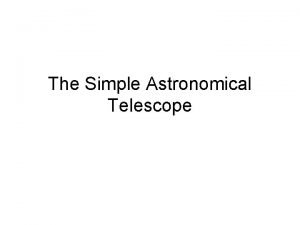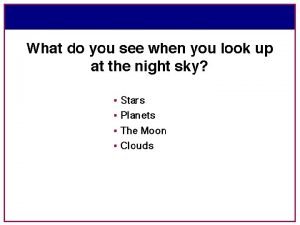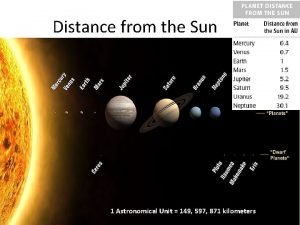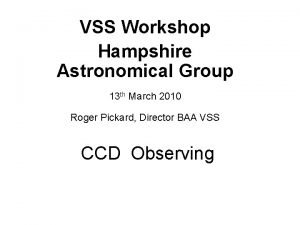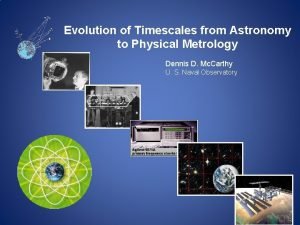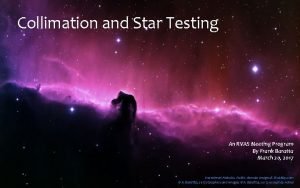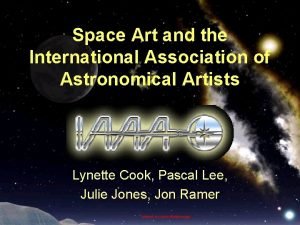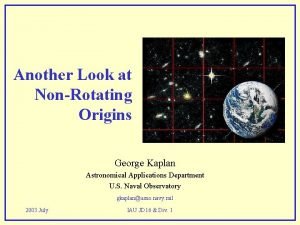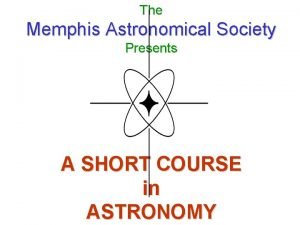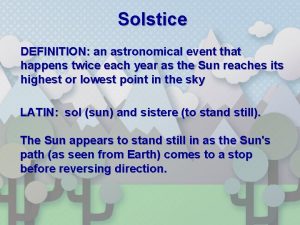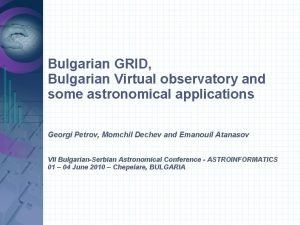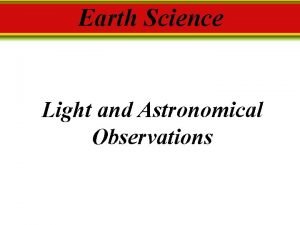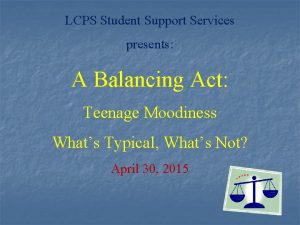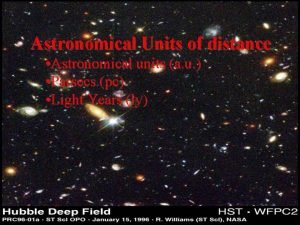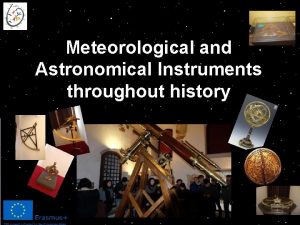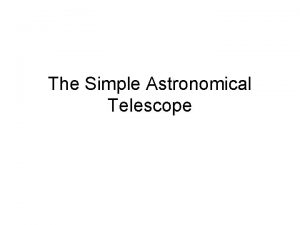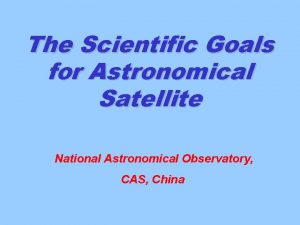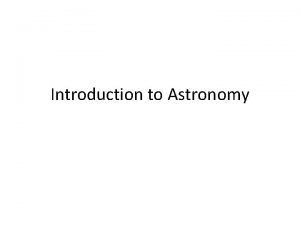Astronomical Science Project Ideas for LCPS HS Student














- Slides: 14

Astronomical Science Project Ideas for LCPS HS Student Research Class Pete Gural 703 -450 -3810 (h) 703 -676 -1767 (w) peter. s. gural@leidos. com Caveat: These are projects with their level of sophistication increasing with each phase in the development steps indicated per page. Not all students may be able to perform all steps. Some require equipment. Others computer skills to extract/process data.

Low Cost “Directional” Cosmic Ray Detector Concept: Use a pair of video low cost CCD video cameras face-to-face to pick up secondary high energy particles originating from cosmic rays and determining their direction of arrival and frequency of occurrence. Equipment: Two PC 164 video cameras and 2 capture dongles (I have available to borrow), low end dedicated PC. Development Steps: 1) Research cosmic ray secondary shower particles and effect on CCDs (single frame transient localized pixel flares) 2) Define optimal geometry, setup equipment and potential shielding (darkened space or tube, lead sheet cover) 3) Set up software for capture and detection (I can provide this or an ambitious/capable student can write this in C) 4) Analyze data collected from the system from a text based list of events = time, positions on the two focal planes.

DVD Spectroscopy Concept: Burn every possible location on a CD, DVD-HD, and Blu-ray disk to create a inexpensive circularly symmetric reflection grating for doing all-aspectroscopy. Application to all-sky meteor spectroscopy. Equipment: Recording media burned with all 1”s. Red, green, … lasers or other spectral light source with known spectral features (emission or absorption lines), sunlight, or streetlights (Na, Hg) for example. Development Steps: 1) Research spectroscopy, emission and absorption lines, gratings for creating spectra. The burn hole spacing in the spiral pattern of the recording media. What is the expected spread of spectral lines. 2) Using known spectral sources calibrate and verify the dispersion (related to grating groove spacing) of each of the four recording media types (nominally CD=1. 6 u, DVD=0. 74 u, HD-DVD=0. 40 u, Blu. Ray=0. 32 u). 3) How consistent is this across different burners for the same media type. 4) Setup with video camera to record passing aircraft at night (red/green acquisition lights, white landing lights). 5) Setup to record moon and planet spectra, meteors, might be sensitive enough for stars.

Slewing Robotic Camera Concept: Demonstrate a very low-cost, fast-slewing, pan-tilt platform for mounting a lightweight CCD video camera to quickly steer a camera in any direction (within 1 second) given a direction to point to via computer command. Useful to point a meteor video camera at a long duration fireball/meteorite dropper. Equipment: Robot-Geek pan-tilt platform + servo motors/controller (I can provide). Low end PC. Option for video camera input to cue pointing of the pan-tilt platform. Development Steps: 1) Build basic pan-tilt plus CCD video camera. Interface to computer. Estimate max slew speed. 2) Cue the system with a separate camera (read the video signal and image process it) determine and command where to point the platform. 3) Tie into real-time meteor detection software and point video camera to meteor before it fades out.

Light Pollution in your County/Region Concept: Estimate the level of light pollution across the county using visual star counts in the constellation Orion coordinating with all schools, and/or via digital SLR photos of the sky. Goal is to determine visual limiting magnitude. Equipment: Orion constellation map, eyeballs, possible camera (not cell phone – too insensitive). Development Steps: 1) Research into light pollution and previous “Project Orion” done in the area in Sky and Telescope. 2) Count the stars visually seen on a clear night within the Orion constellation bordered by gamma, kappa, Rigel, and Betelgeuse. 3) Coordinate with schools/students across the county to collect the same night 4) Compare to previous light pollution map and satellite observations of lighting for this area. 5) Extend to using more precise measurements with a camera to validate counts limiting visual magnitude

Mining of the Meteor Orbit Databases Concept: Data mine the video meteor orbit data bases (Sonotaco, CAMS, CMN, VMDB) to extract meteoroid stream (meteor shower) characteristics for begin/end heights, entry velocity, radiant position, radiant drift, Keplerian orbital parameters, duration of activity. Fill out missing data in the meteor stream data base. Equipment: Data analysis application or spreadsheet (e. g. Excel, Matlab, Octave). Data sets available grouped by meteoroid stream. IAUNo Code Shower. Name 1 CAP alpha Capricornids 2 STA Southern Taurids La. Sun Ra De d. Ra d. De Vg a q e peri node inc 127 308. 4 -9. 6 0. 9 0. 3 22. 8 2. 53 0. 59 0. 77 269 127. 7 7 224 49. 4 13 0. 73 0. 18 28 2. 07 0. 352 115. 4 37. 3 5. 4 Development Steps: 1) Research into basic parameters describing meteor showers and dynamical orbital parameters. 2) Data mine the data bases to verify or fill in as necessary key parameters for showers of the IAU meteor center. 3) Examine any change of parameters over the multi-day activity period of meteor showers

Meteor Triangulation Concept: Establish a video meteor observation site at one or more of the high schools in the county and collect/process data from each clear night and analyze pooled observations. Goal is add to the local CAMS network. Equipment: WATEC 902 H 2 + 12 mm Pentax f/1. 2 lens + Orion video dongle + enclosure mount (recommended imaging system) cost $500 plus PC. CAMS collection and processing software provided free. Development Steps: 1) Build out and place camera system in secure location (HS roof-top ? ). 2) Collect and process each clear night’s camera data. 3) Merge multiple site camera data (6 cameras currently in network) to get meteor trajectory and orbits. 4) Analyze orbit data for known meteor streams. 5) Extension to telescopic triangulation of meteors from two sites 3 -5 km apart (I have one set of pair of systems needed) for high resolution meteor tracks and orbit estimation feasibility from short baseline parallax.

Meteor Light Curve Taxonomy Concept: Data mine the video meteor measurements of light curves to develop a taxonomy of classification and possible dependency on meteor shower and/or time of year. Equipment: Data analysis application or spreadsheet (e. g. Excel, Matlab, Octave). Data sets available as text files. Magnitude Light Curve vs. Height Ground Track Latitude / Longitude Height vs. Down Range Development Steps: 1) Research previous work done in meteor light curve (change in intensity over time) and attempts at taxonomy. 2) Characterize the data in the small sample of Mid-Atlantic CAMS data. 3) Apply to the larger data set from CAMS, California (if can be made available)

Daylight Meteor Detection Concept: Use a narrow band filter or specific filter tuned to a strong meteor emission line (interference filter) to capture meteors in daylight. Caveat – very low probability this will work. Equipment: CCD video camera and filters + capture dongle + capture software (I can supply). Low end PC. Development Steps: 1) Setup camera and computer for video meteor capture and processing. 2) Monitor data collected each clear day. 3) Target morning twilight hours for meteor activity detection in less bright sky conditions (higher rates than evening twilight).

Walking Orrery Concept: Student can research and setup a temporary (or permanent) walking Orrery. See http: //star. arm. ac. uk/orrerynav. html

Meteor Trajectory Estimation Concept: Compare three methods of meteor trajectory estimation to determine the best technique on average (Ceplecha’s 1987 intersecting planes and two variants of the least squares method from Borovicka 1990). Equipment: Trajectory software function in C (I can provide or the student could attempt to write). C, Java, Matlab, or Octave familiarity. Line ar Tr ack Camera 1 Measurement Vectors Camera 2 Measurement Vectors Development Steps: 1) Research and understand existing methods – possibly write functional modules that solve for trajectory. 2) Build a simulation capability by modeling straight line entry into the 3 D atmosphere observed by >=2 sites. 3) Compare algorithm performance for a variety of trajectories via Monte Carlo simulation

Double Star Characterization Concept: Is there an equivalent to the Hertzsprung-Russel diagram, but adapted to double stars (e. g. surface temperature of star 1 to surface temperature of star 2). Equipment: Double-star data base catalog downloaded from the web. Development Steps: 1) Research and understand the H-R diagram, star spectral type/surface temperature, luminosity. 2) Do double stars fall into localized areas of a two-axis plot (examine different star attributes for axis 1 and axis 2). 3) If so, consider reasons why that might be so such as the main sequence and stellar evolution paths, is there a relationship between each pair in luminosity or temperature (size). 4) What about triple star systems.

Overlay Meteor Tracks onto a Planetarium App Concept: Visualize a night’s collection of meteor tracks on a projected star background (preferably gnomonic). Equipment: Planetarium program with external interface or plug-in capability for superimposing data; Meteor track text file. Development Steps: 1) Research to find a planetarium program that could ingest begin and end points of a meteor track and superimpose on a star field (e. g. Stellarium). Add active meteor radiant positions. 2) Alternatively write a star + meteor track visualization capability.

Create KML to Overlay 3 D Meteor Tracks on Google Earth Concept: Visualize the reconstructed three-dimensional meteor track(s) within Google Earth by writing trajectory (straight line begin/end points) in KML format. Equipment: Meteor trajectory text files containing begin and end point geo-positions of latitude, longitude, and altitude. Computer with Google Earth. Software development in C, Java, or using a scripting language. Development Steps: 1) Understand meteor trajectories in a three-dimensional sense. 2) Parse the meteor trajectory files and convert to a KML format for visualization. 3) Add sight lines from each observing station as an overlay layer 4) Extend to mapping site video camera viewing geometries for a camera network to their intersection and overlap at the meteor ablation layer in the atmosphere (~90 km).
 Science national honor society project ideas
Science national honor society project ideas Telescope diagram
Telescope diagram Astronomical coordinates
Astronomical coordinates Seasons diagram
Seasons diagram Hampshire astronomical group
Hampshire astronomical group Astronomical time scale
Astronomical time scale Collimation star test
Collimation star test Julie ramer
Julie ramer Guildford astronomical society
Guildford astronomical society Astronomical applications department
Astronomical applications department Memphis astronomical society
Memphis astronomical society An event that happens twice a year
An event that happens twice a year Astronomical
Astronomical Astronomical clock lyon france
Astronomical clock lyon france Synergy lcps
Synergy lcps

